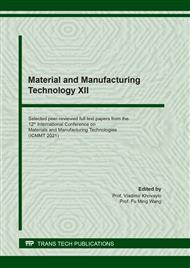p.57
p.63
p.71
p.79
p.85
p.95
p.103
p.109
p.117
Titanium Dioxide-Infused Hybrid Electrolytes Based on Ionic Liquids Containing Protic Cation: Effect of Solute Concentration on the Electrochemical and Interfacial Properties
Abstract:
The efficiency of batteries, supercapacitors, and dye-sensitized solar cells for energy storage and harvesting processes depends on the relative energy levels and the charge transfer kinetics at the electrode/electrolyte interface. Owing to their distinctively tunable properties including non-volatility, low flammability, wide electrochemical stability, inherent conductivity, and high thermal stability, developing low viscosity ionic liquids (ILs) is vital for energy device fabrication. In this work, 1-methylimidazolium ILs were synthesized by a one-step sonochemical solventless reaction and were characterized using FT-IR, 1H-NMR, and 13C-NMR spectroscopy to confirm their structure. Hybrid electrolytes based on the 1-methylimidazolium chloride ([MIM]Cl) infused with titanium dioxide (TiO2) particles at varying concentrations were prepared, and the effect of solute concentration on their electrochemical and interfacial properties was investigated. Ionic conductivity results revealed that the as-prepared [MIM]Cl-TiO2-0.5% hybrid electrolytes exhibited a higher conductivity in comparison with neat [MIM]Cl. Furthermore, cyclic voltammetry was used to determine their electrochemical stability window and revealed that a wide ESW of 3.56 ± 0.01 V was also obtained by [MIM]Cl-TiO2-0.5% attributed to the enhanced surface tension of 35.92 ± 0.07 mN/m due to the addition of TiO2 particles. This observation was validated by the generated pendant drop images showing the remarkable correlation of solute concentration with surface tension and ESW of the hybrid electrolytes. The utilization of these metal oxide-infused solvent-free IL as a substitute for aqueous-and organic-based electrolytes can address issues on electrochemical stability and provide insight in suppressing self-discharge processes, especially when used at higher potentials.
Info:
Periodical:
Pages:
85-93
Citation:
Online since:
August 2021
Authors:
Keywords:
Price:
Сopyright:
© 2021 Trans Tech Publications Ltd. All Rights Reserved
Share:
Citation:


